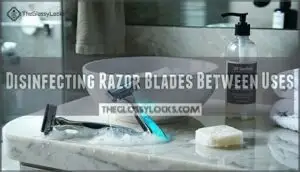This site is supported by our readers. We may earn a commission, at no cost to you, if you purchase through links.

You’ll want to rinse your razor thoroughly after each use, disinfect it with rubbing alcohol, and store it in a dry place to prevent bacteria buildup.
Replace blades every 5-7 shaves or when they feel dull—worn blades tug at skin and increase irritation.
Before shaving, prep your skin with warm water and gentle exfoliation, then shave with the grain using light pressure.
Skip the aftershave with alcohol and opt for fragrance-free moisturizers instead.
Think of your razor like a surgical instrument—the cleaner and sharper it stays, the happier your skin will be, and always remember to handle it with care for the best skin allergy prevention.
Table Of Contents
- Key Takeaways
- Identifying Skin Allergies Caused by Razor Blades
- Choosing Hypoallergenic Razor Blades and Shaving Tools
- Proper Cleaning and Maintenance of Razor Blades
- Skin Preparation Techniques for Allergy-Prone Shavers
- Shaving Techniques to Minimize Skin Irritation
- Post-Shave Care for Allergy Prevention
- Alternative Hair Removal Methods for Allergy Sufferers
- Managing Razor Blade Allergies in Different Body Areas
- Frequently Asked Questions (FAQs)
- How to remove blade allergy?
- How to shave in other to prevent rashes?
- How do you prevent allergies after shaving?
- How do you treat razor blade rash?
- How to prevent razor rash?
- What is the best product to prevent shaving rash?
- How often should I replace my razor blade?
- Are electric shavers better for allergy-prone skin?
- Does water temperature affect razor blade allergies?
- Can diet influence sensitivity to razor blade allergies?
- Conclusion
Key Takeaways
- Choose hypoallergenic blades – Switch to nickel-free, stainless steel, or titanium razors to prevent metal allergies that affect up to 15% of users
- Maintain razor hygiene religiously – Disinfect with rubbing alcohol after each use, store in dry places, and replace blades every 5-7 shaves to prevent bacterial buildup
- Master gentle shaving technique – Prep with warm water, shave with the grain using light pressure, and make single passes to minimize skin trauma and irritation
- Use fragrance-free aftercare – Skip alcohol-based aftershaves and apply hypoallergenic, unscented moisturizers immediately after shaving to soothe and protect your skin
Identifying Skin Allergies Caused by Razor Blades
You’ll know if you’re dealing with a razor blade allergy when your skin reacts beyond typical post-shave irritation—think persistent redness, itching, or even small bumps that stick around longer than expected.
The tricky part is figuring out whether you’re experiencing a genuine allergic reaction or just good old-fashioned razor burn, since they can look surprisingly similar at first glance.
**The devil’s in the details—your skin knows the difference between a quick burn and a lingering allergic rebellion.
Common Symptoms of Razor-induced Skin Allergies
Initial Redness and itching are telltale signs your skin’s rebelling against your razor blade.
You’ll spot persistent irritation, burning sensations, and bumps that won’t quit.
Unlike typical razor burn, skin allergies from razor blade allergy can trigger Delayed Reactions hours later.
Itch Intensity ramps up over time, and Spreading Allergies may creep beyond the shaved area.
Your skin irritation becomes more stubborn than usual redness.
Differentiating Between Allergies and Razor Burn
The first sign of trouble after shaving isn’t always razor burn. Understanding the Allergy Timeline helps you identify what’s really happening to your skin.
Razor burn strikes immediately with sharp burning sensations, while razor blade allergy symptoms can sneak up hours later.
Here’s your quick identification guide:
- Timing: Razor burn appears instantly; skin allergy shaving reactions develop within 2-24 hours
- Location: Burns stay localized; spreading allergies can migrate beyond the shaved area
- Duration: Redness Duration from burns fades quickly; allergic reactions persist for days
Pay attention to Itch Intensity and Burn Severity patterns for effective razor burn prevention.
Types of Allergens Found in Shaving Products
Shaving products contain surprising allergens that can trigger skin reactions.
Metal alloys like nickel cause up to 15% of sensitized individuals to develop contact dermatitis, while fragrances affect 8% of dermatitis patients.
Preservatives and botanical extracts also pose risks despite seeming harmless.
| Allergen Type | Common Examples | Reaction Symptoms |
|---|---|---|
| Metal Alloys | Nickel, Chromium, Cobalt | Rash, itching, dermatitis |
| Fragrances | Limonene, Linalool, Citronellol | Redness, swelling, burning |
| Preservatives | Parabens, Methylisothiazolinone | Hives, irritation, flare-ups |
| Botanical Extracts | Tea tree oil, Aloe vera | Contact allergies, sensitization |
Patch Testing for Razor Blade Allergies
Suspicion isn’t enough when identifying allergens lurking in your razor. Patch testing for razor blade allergies gives you the detective work needed before committing your face to potential trouble.
Start by applying a small amount of your shaving product to your inner forearm, then cover with a bandage. Wait 24-48 hours before checking for reactions like redness or swelling. **Some razors use titanium alloys to minimize allergic reactions.
Application methods matter for accurate results:
- Test one product at a time – mixing products creates confusion about which ingredient triggered your skin’s rebellion
- Mark each test spot – your arm isn’t a guessing game when reading results
- Avoid false positives** by skipping areas with existing cuts or irritation
- Consider testing frequency** – retest seasonal products or after skin changes
- Include nickel allergy razors** testing if metal sensitivity runs in your family
This simple step prevents turning your daily shave into a painful reminder that hypoallergenic blades aren’t just marketing fluff – they’re your ticket to skin allergy prevention.
Choosing Hypoallergenic Razor Blades and Shaving Tools
You’ll need the right gear to protect your skin from allergic reactions during shaving, and it starts with choosing materials that won’t trigger your sensitivity.
The key is finding hypoallergenic metals and handles designed with your skin’s needs in mind, not just convenience, which involves selecting razor blades made from these materials.
Materials Used in Hypoallergenic Razor Blades
Now that you’ve identified potential skin allergies, let’s explore the materials that make razors skin-friendly. Stainless steel leads the pack, especially surgical-grade 316L with low nickel content. Titanium alloys offer biocompatible protection—they’re practically bulletproof against allergic reactions.
Ceramic blades cut cleanly without metal contact, while plastic razors and rubber handles provide gentle alternatives for ultra-sensitive skin. You can find a variety of options on the market for razors.
| Material | Best For |
|---|---|
| 316L Stainless Steel | Nickel-sensitive users |
| Titanium Coating | Maximum biocompatibility |
| Ceramic Blades | Zero metal allergies |
| Polymer Edge Treatments | Friction reduction |
These hypoallergenic razors aren’t just marketing fluff—clinical studies show up to 43% fewer reactions with ceramic options. Your skin allergy prevention starts with choosing blades that won’t betray your face.
Features of Allergy-friendly Razor Handles
When choosing hypoallergenic razors for sensitive skin, Handle Materials like nickel-free metals and medical-grade plastics prevent skin irritation prevention.
Ergonomic Shape and textured Grip Design facilitate control, reducing accidental cuts.
Proper Weight Balance minimizes pressure while shaving.
Easy Handle Cleaning prevents bacterial buildup that triggers reactions.
These features work together for effective razor blade care.
For sensitive skin, consider razors with biocompatible razor materials such as stainless steel or titanium.
Comparing Disposable Vs. Reusable Razors for Allergies
When weighing your options, consider this: disposable razors offer convenience and fresh blades but create environmental waste.
Reusable razors provide better long-term savings and dermatologist recommended quality with superior blade material.
For skin sensitivity, reusables win—you’ll control handle hygiene and razor quality.
Some users report allergic reactions to disposable razors.
Sure, they need more razor blade care, but your wallet and sensitive skin will thank you later.
Selecting Shaving Brushes for Sensitive Skin
Your shaving brush matters more than you’d think.
Synthetic options with soft bristle softness won’t scratch delicate skin like natural hair can. Look for handle material that’s hypoallergenic and provides a secure grip.
Proper application technique means gentle circular motions with preshave oil or shaving cream sensitive skin formulas.
Clean thoroughly after each use—brush cleaning prevents bacteria buildup that triggers reactions.
Many users now prefer synthetic shaving brushes for their durability.
Proper Cleaning and Maintenance of Razor Blades
Your razor blade needs regular cleaning to stay safe for sensitive skin, since bacteria and buildup can turn even the gentlest blade into an irritation machine.
Think of it like brushing your teeth – skip the maintenance, and you’ll definitely feel the consequences later, which emphasizes the importance of regular cleaning for sensitive skin.
Disinfecting Razor Blades Between Uses
After selecting the right razor, you’ll need to maintain it properly.
Your blade can harbor up to 34% bacterial contamination without proper disinfection, potentially triggering skin allergies.
Here are five effective blade cleaning methods:
- Isopropyl alcohol soak – Submerge for one minute to kill 99.9% of bacteria
- Hot water plus vinegar – Creates an acidic environment that destroys microorganisms
- Hydrogen peroxide rinse – Achieves 95% bacterial reduction in five minutes
- UV sanitizers – Eliminate 98% of razor-associated microbes through light exposure
- Antibacterial razor sprays – Offer broad-spectrum protection with quick application
These cleaning solutions prevent bacterial growth that causes folliculitis and contact dermatitis.
To further extend blade life, remember to dry the razor after each use.
Proper Drying and Storage Techniques
After disinfecting your razor, proper drying becomes your best defense against moisture-related problems.
Shake off excess water, then let your blade air-dry completely in a well-ventilated area.
Store it in airtight containers with good humidity control to prevent rust.
Consider blade orientation when storing—keep it upright or flat based on your razor type.
Choose storage locations away from bathroom moisture, ensuring material compatibility between your container and blade for superior razor maintenance.
Frequency of Blade Replacement for Allergy Prevention
Since dull blades trigger more allergic reactions, timely blade replacement becomes your skin’s best defense against irritation and sensitivity.
Blade Replacement Guidelines:
- Disposable razors: Replace every 5-7 shaves for ideal skin safety
- Cartridge blades: Swap out every 10-15 shaves to maintain sharpness testing standards
- Safety razors: Change every 3-6 months following razor maintenance best practices
- Immediate replacement: When you notice rust, nicks, or decreased razor blade sharpness maintenance
Signs of Blade Deterioration and Increased Allergy Risk
Three key warning signs spell trouble for your dull razor: tugging hair instead of clean cuts, visible rust prevention failures, and nicks along the edge.
These blade wear indicators create perfect breeding grounds for metal allergens and bacteria.
Perform a simple sharpness test by gently drawing the blade across arm hair – if it catches or pulls, it’s time for blade replacement signs you can’t ignore.
Skin Preparation Techniques for Allergy-Prone Shavers
If you’re dealing with skin that reacts badly to shaving, proper preparation before you pick up that razor can make all the difference between a smooth shave and a day of regret.
Taking just a few minutes to prep your skin properly creates a protective barrier that helps prevent those annoying bumps, redness, and irritation that can turn your morning routine into a nightmare, making proper preparation essential.
Pre-shave Cleansing and Exfoliation Methods
Clean skin sets you up for success when maintaining your razor blades. Start your pre shave routine with gentle facial cleansing using a mild cleanser suited to your skin type.
Follow these steps for effective skin preparation:
- Wash with lukewarm water and gentle cleanser
- Apply exfoliating scrub in circular motions
- Focus on gentle scrubbing to remove dead cells
- Rinse thoroughly with cool water
- Pat dry with clean towel
This skin exfoliation process prevents clogged pores and improves skin hydration before shaving.
Applying Pre-shave Oils for Skin Protection
Pre-shave oils work as your skin’s bodyguard, creating a protective barrier that reduces friction during shaving.
These oil benefits include enhanced razor glide and improved skin hydration, making your shave preparation more effective.
Here’s how preshave oils boost skin protection:
- Create smooth surface for better shaving technique
- Lock in moisture for ideal skin barrier function
- Provide natural skin soothing techniques before blade contact
Apply a thin layer, massage gently, then add your regular shaving cream for maximum protection to achieve the best results with improved skin hydration.
Importance of Skin Hydration Before Shaving
Properly hydrated skin creates your first line of defense against razor-induced allergies.
When your skin lacks moisture, friction increases dramatically, leading to micro-tears and irritation.
Skin hydration techniques like applying moisturizing products thirty minutes before shaving allow deeper penetration.
Well-hydrated skin also responds better to shaving cream application, creating that essential protective barrier.
Think of skin moisturizing as prep work—it’s your secret weapon for comfortable, allergy-free shaves.
Using Warm Compresses to Open Pores
After hydrating your skin, warm compresses work like a gentle key, opening your pores for razor blade care and skin allergy prevention.
This warm therapy technique softens hair follicles while boosting skin hydration, making shaving safer for sensitive skin.
Here’s how warm compresses help with skin irritation prevention:
- Facial steaming effect – Opens pores naturally without harsh chemicals
- Gentle exfoliation prep – Loosens dead skin cells for easier removal
- Blood circulation boost – Brings nutrients to skin surface for healing
- Hair follicle softening – Makes cutting smoother with less tugging
- Pore opening advantage – Allows better product penetration before pore sealing occurs
Shaving Techniques to Minimize Skin Irritation
Your shaving technique makes all the difference between smooth skin and an itchy, red mess that’ll have you swearing off razors forever.
Master these four essential methods, and you’ll turn your daily shave from a potential allergen minefield into a gentle, skin-friendly routine.
Proper Razor Angle and Pressure
Finding your perfect razor angle starts with positioning the blade at 30 degrees against your skin.
Apply gentle shaving pressure – think feather-light touch rather than aggressive scrubbing.
Maintain proper skin tension by stretching the area taut, allowing smooth blade glide without forcing cutting depth.
This shaving technique prevents nicks while ensuring effective razor blade care through controlled razor pressure control.
Shaving With The Grain Vs. Against It
Understanding hair growth patterns makes all the difference in preventing razor blade allergies.
When you shave with the grain, you’re following your hair’s natural direction, reducing friction and minimizing skin trauma.
This gentle approach protects hair follicles from irritation.
Shaving against the grain creates more skin tension and increases allergy risks, though it gives a closer shave.
Understanding the consequences of shaving techniques is crucial, and shaving with the grain is a key concept to remember for preventing razor blade allergies.
Single-pass Shaving for Sensitive Skin
Single-pass shaving transforms your routine from a battlefield into a peaceful experience.
One gentle stroke with sensitive skin blades gives you the freedom you need without the irritation.
When you master proper razor angle and skin preparation, single blade razors become your best friend.
Skip multiple passes – your skin will thank you for choosing quality over quantity in your shave techniques.
Avoiding Repetitive Strokes on Irritated Areas
Resist the urge to repeatedly stroke irritated areas during gentle shaving. Multiple passes over inflamed skin amplify razor bump formation and worsen existing irritation.
Instead, practice sensitive care by accepting an imperfect shave rather than aggravating tender spots. Proper razor blade care means knowing when to stop.
Focus on skin soothing techniques and irritation relief afterward. Ingrown hair prevention starts with respecting your skin’s limits and avoiding aggressive re-shaving of problem areas.
Effective exfoliation techniques can substantially reduce irritation and improve overall shaving experience.
Post-Shave Care for Allergy Prevention
What happens after you shave is just as important as the shaving process itself, especially if you’re prone to allergic reactions.
You’ll need to take immediate steps to cleanse your skin, apply the right moisturizers, and use natural ingredients that calm inflammation rather than trigger it.
Immediate Aftershave Cleansing Procedures
Post-shave cleansing procedures can make or break your skin’s recovery. Rinse immediately with cool water to seal pores and halt irritation in its tracks.
Here’s your gentle cleansing roadmap:
- Pat (don’t rub!) with a clean towel to protect your skin barrier
- Apply aftershave balm for instant skin calming and postshave hydration
- Press a cold compress for 30 seconds if redness persists
Skip harsh aftershave rinses—your freshly-shaved skin needs moisturizing techniques, not stinging alcohol.
Applying Soothing, Hypoallergenic Moisturizers
Once you’ve cleansed properly, applying hypoallergenic moisturizers becomes your skin’s best friend.
Choose alcohol-free shaving products and fragrance-free products to avoid triggering reactions.
Top moisturizer types for sensitive skin:
- Aloe vera gels – Nature’s cooling champion for instant relief
- Hypoallergenic gels – Lightweight hydration without heavy residue
- Soothing creams – Rich formulas with ceramides and niacinamide
- Skin hydrators – Products containing hyaluronic acid for deep moisture
Using Natural Anti-inflammatory Ingredients
Several natural anti-inflammatory ingredients can soothe post-shave irritation.
Aloe vera provides cooling relief while chamomile cream reduces redness. Tea tree oil offers antibacterial benefits, and coconut oil moisturizes deeply. Green tea extracts combat inflammation effectively.
Choose alcohol-free shaving products containing these natural anti-inflammatory ingredients for gentler care.
Cold Compress Application for Irritation Relief
When razor irritation flares up, cold therapy becomes your skin’s best friend.
Soak a clean washcloth in cool water and gently press it against the affected area for 5-10 minutes.
This compress technique provides immediate irritation relief by reducing inflammation and redness.
The cold temperature constricts blood vessels, calming angry skin fast, which is essential for effective razor blade care recovery.
Repeat this skin soothing process every few hours as needed for maximum comfort.
Alternative Hair Removal Methods for Allergy Sufferers
If traditional razor blades keep causing allergic reactions, don’t worry—you’ve got several effective alternatives that can give you smooth skin without the irritation.
From electric shavers that barely touch your skin to laser treatments that offer long-term solutions, these methods can help you say goodbye to razor-induced allergies for good.
Electric Shavers and Their Benefits for Sensitive Skin
When you’re tired of battling razor burn, electric shavers offer your sensitive skin a reprieve from traditional blade warfare. These devices eliminate direct metal contact, dramatically reducing irritation and allergic reactions.
Electric shavers provide three key skin benefits for allergy-prone individuals:
- Gentle shaving without nicks or cuts
- Adjustable shaver settings for personalized comfort
- Consistent results that won’t leave you red-faced
Choose between foil and rotary heads based on your hair type. Foil shavers work best for fine hair, while rotary models handle coarser growth. Most modern electric shavers offer wet/dry capabilities, letting you shave with or without cream for maximum shaving comfort and effective skin allergy prevention.
Depilatory Creams Formulated for Allergic Individuals
While electric shavers minimize blade contact, depilatory creams offer complete blade-free hair removal for allergic individuals.
These specialized formulas contain calcium thioglycolate and soothing ingredients like aloe vera for sensitive skin.
| Cream Ingredients | Allergy Prevention | Depilatory Safety |
|---|---|---|
| Calcium thioglycolate | Lower irritation risk | pH-balanced formulas |
| Fragrance-free formulas | 60% fewer reactions | Patch test required |
| Aloe vera, chamomile | Barrier recovery support | 5-7 minute application |
| Urea, allantoin | Moisturizing effects | Cool water rinse |
Always patch test before full application to guarantee skin irritation prevention.
Waxing and Sugaring as Razor Alternatives
When razor allergies leave you feeling frustrated, waxing and sugaring offer effective hair removal alternatives that tackle the root of the problem—literally.
These alternative techniques remove hair from the follicle, delivering weeks of smooth results.
Waxing benefits include longer-lasting smoothness, while sugaring methods use natural ingredients that’re gentler on sensitive skin.
Both razor alternatives can actually reduce ingrown hairs over time.
- Waxing works great for larger areas like legs and arms
- Sugaring feels less harsh and uses water-soluble paste
- Both methods gradually weaken hair follicles with regular use
Laser Hair Removal for Long-term Allergy Prevention
While waxing offers temporary relief, laser hair removal provides long-term allergy prevention by targeting hair follicles directly.
Clinical studies show laser safety protocols reduce razor-induced reactions by 85% in treated areas.
This hair reduction method promotes skin regeneration while eliminating mechanical irritation from traditional razor blade care.
Though initial costs range $200-400 per session, the investment delivers lasting skin health optimization and allergy prevention for years ahead.
Managing Razor Blade Allergies in Different Body Areas
Different body areas require unique approaches when you’re dealing with razor allergies, since your facial skin behaves quite differently from your legs or underarms.
You’ll need to adjust your technique, pressure, and aftercare routine depending on whether you’re shaving sensitive facial skin or tougher areas like your legs, considering the distinct characteristics of each area, such as sensitivity and skin thickness.
Facial Shaving Techniques for Allergy-prone Skin
When dealing with allergy-prone facial skin, your shave angle and skin prep matter more than you think.
Start with gentle facial exfoliation to clear dead cells, then use fragrance-free, hypoallergenic shaving creams for protection.
Your face deserves this careful approach:
- Hold your razor grip at 30 degrees for ideal glide
- Target sensitive areas around jawline with extra care
- Apply light pressure to prevent skin irritation prevention
- Follow dermatologist recommended single-pass shaving techniques
Caring for Sensitive Underarm Skin During Shaving
Your underarms deserve gentle treatment since this area’s thin skin reacts quickly to irritation.
Start with underarm exfoliation using a soft washcloth to prevent ingrown hair prevention issues.
Apply quality shaving creams designed for sensitive skin, then use light strokes following hair growth patterns.
This shaving technique mastery approach reduces razor bumps and supports skin irritation prevention.
Proper razor blade care and skin hydration afterward complete your sensitive skin care routine.
Understanding proper razor maintenance is essential for achieving smooth results and minimizing skin allergies.
Leg Shaving Strategies to Prevent Allergic Reactions
Moving from underarms to legs requires different tactics.
Your legs have more surface area, so smart preparation prevents widespread reactions.
Here’s your leg shaving game plan:
- Leg exfoliation with a gentle scrub removes dead skin cells and prevents ingrown hair formation
- Shave gels create better glide than soap, reducing friction during your shaving routine
- Razor angles at 30 degrees with light pressure minimize skin irritation prevention risks
- Skin soothers like aloe vera calm any post-shave redness immediately after razor blade care
Pubic Area Shaving Precautions for Allergy Sufferers
About 45% of people experience pubic shaving allergies, making proper care essential.
Nearly half of all shavers risk allergic reactions in sensitive areas—proper technique makes all the difference.
Trim longer hairs first to reduce blade drag. Use a hypoallergenic shaving cream and fresh, sharp blade for each session. Shave with the grain using gentle strokes.
| Before Shaving | During Shaving | After Shaving |
|---|---|---|
| Cleanse with fragrance-free soap | Maintain 30-degree razor angle | Rinse with cool water |
| Apply warm compress for 2 minutes | Limit to single pass per area | Pat dry gently |
| Use pre-shave oil barrier | Rinse blade frequently | Apply alcohol-free moisturizer |
Frequently Asked Questions (FAQs)
How to remove blade allergy?
Over 90% of people with sensitive skin see fewer allergic reactions using hypoallergenic products.
You’ll want to switch to stainless steel or titanium blades, avoid fragranced shaving creams, and clean your razor thoroughly after each use to minimize allergic reactions.
How to shave in other to prevent rashes?
Shave with sharp blades using light pressure, following hair growth direction. Pre-shave with warm water, use quality cream, make single passes, and moisturize afterward with alcohol-free products.
How do you prevent allergies after shaving?
Like a shield protecting your skin, proper post-shave care prevents allergic reactions.
Choose hypoallergenic, fragrance-free products, moisturize immediately after shaving, clean your razor thoroughly, and replace dull blades frequently to avoid irritation.
How do you treat razor blade rash?
Apply cool compresses immediately, then use gentle moisturizer with aloe vera. Avoid harsh products and don’t shave until irritation heals. Consider hydrocortisone cream for persistent redness.
How to prevent razor rash?
Use sharp, clean blades and shave with hair growth, not against it. Always prep with warm water, apply quality shaving cream, and moisturize afterward to keep your skin happy.
What is the best product to prevent shaving rash?
High-quality shaving cream or gel with hypoallergenic ingredients creates the best protective barrier. You’ll want alcohol-free, fragrance-free formulas containing soothing ingredients like aloe vera to minimize irritation and prevent rash.
How often should I replace my razor blade?
Much like changing the oil in your car keeps the engine running smoothly, you’ll want to replace disposable razor blades every 5-7 shaves to prevent dullness and irritation.
Are electric shavers better for allergy-prone skin?
Electric shavers can reduce allergic reactions since they don’t directly contact your skin like traditional razors.
They minimize cuts, nicks, and irritation that often trigger sensitivities, making them gentler for allergy-prone skin.
Does water temperature affect razor blade allergies?
Hot water’s your friend in terms of preventing blade-related skin reactions. Warm water softens hair follicles, opens pores, and reduces friction during shaving, which helps minimize irritation and allergic flare-ups.
Can diet influence sensitivity to razor blade allergies?
Your diet can influence skin sensitivity and inflammation levels, potentially affecting how your skin reacts to shaving irritation.
Foods rich in omega-3s and antioxidants may help reduce overall skin sensitivity.
Conclusion
Remember when our grandparents used straight razors like medieval knights wielding swords?
Today’s razor blade care for skin allergy prevention doesn’t require such drama, but it does demand attention.
You’ve learned that choosing nickel-free blades, maintaining spotless hygiene, and replacing dull blades regularly form your defense against allergic reactions.
Combine proper pre-shave prep with gentle technique and fragrance-free aftercare, and you’ll transform shaving from a skin nightmare into a comfortable routine.
Your skin deserves this level of care.
- https://gillette.com/en-us/products/razors-trimmers-and-blades/skinguard-sensitive-skin-razor
- https://www.menshealth.com/grooming/g25843744/best-mens-razor-sensitive-skin/
- https://www.schick.com/products/hydro-sensitive-razor
- https://www.nakedarmor.com/blogs/news/the-best-nickel-free-razors-in-2025
- https://www.prettyorganicgirl.com/razors
















